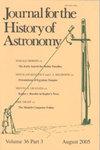Amici的双星观测
IF 0.3
3区 哲学
Q3 HISTORY & PHILOSOPHY OF SCIENCE
引用次数: 0
摘要
1824年4月,作为父亲威廉去世后欧洲之旅的一部分,英国天文学家兼博学家约翰·赫歇尔(1792–1871)在意大利天文学家乔瓦尼·巴蒂斯塔·阿米奇(1786–1863)位于摩德纳的天文台会见了他。当时,与多尔帕特的赫歇尔和威廉·斯特鲁夫(1793-1864)一起,阿米奇是少数测量双星的天文学家之一。他们的研究由赫歇尔的父亲开创,引起了人们的兴趣,因为(在光学双星的情况下)他们提供了测量视差的机会,或者(在真正的双星的情况)提供了从观测数据中推导轨道参数的机会,就像费利克斯·萨瓦里(1797-1841)在1827年第一次做的那样。测量双星处于观测精度的边缘,确定轨道参数取决于高质量的光学器件、精确的微米和来自尽可能多的不同观测者的数据。年轻的赫歇尔无论走到哪里,都鼓励建立一个双星观测者网络,他后来在天文学方面的大部分工作都涉及合成和发布这些数据。然而,与斯特鲁夫和赫歇尔不同的是,阿米奇从未发表过他自己广泛的双星观测结果。阿米奇的双星观测从1815年一直持续到1851年(尽管大多数观测时间是在1824年至1826年),现在可以在Edizioni Tassinari的精美版本中找到,作为《国家歌剧院》的第二卷。该卷包括一篇23页的意大利语和英语引言,提供了19世纪双星研究的背景,以及对阿米奇仪器的讨论和对他与双星有关的信件的调查。引言解释了为什么Amici和他的仪器对双星研究很重要,但并没有解释为什么双星研究对Amici很重要。毫无疑问,该系列的其他几卷都包含了阿米奇的传记细节,但如果没有他的生活和职业生涯的草图,单凭这本书的读者就不知道双星在阿米奇的作品中扮演了什么角色,他的机构背景,也不知道他为什么在1831年从摩德纳搬到佛罗伦萨。这本书的大部分(200页)都是对阿米奇六本未出版的双星笔记本的高质量逐页复制。第一本笔记本形成了对阿米奇目录的介绍,显示了威廉·赫歇尔双星类的影响。其他的笔记本包含了他的观察,大致按时间顺序排列。1032417 JHA0010.1177/02182826211032417《天文学史杂志》书评2021本文章由计算机程序翻译,如有差异,请以英文原文为准。
Amici’s double star observations
In April 1824, as part of an extended tour through Europe following the death of his father William, the British astronomer and polymath John Herschel (1792–1871) met the Italian astronomer Giovanni Battista Amici (1786–1863) at the latter’s observatory in Modena. At the time, along with Herschel and Wilhelm Struve (1793–1864) in Dorpat, Amici was among the few astronomers measuring double stars. Their study, pioneered by Herschel’s father, was of interest because (in the case of optical doubles) they provided opportunity for measuring parallax or (in the case of true binaries) a chance to derive orbital parameters from observational data, as Felix Savary (1797–1841) would do for the first time in 1827. Measuring double stars was at the edge of observational precision, and determining orbital parameters depended on high-quality optics, precise micrometers, and data from as many different observers as possible. The younger Herschel encouraged a network of double star observers wherever he went, and much of his later work in astronomy involved synthesizing and publishing this data. Unlike Struve and Herschel, however, Amici never published his own extensive double star observations. Amici’s double star observations, stretching from 1815 to 1851 (although most are from 1824–1826), are now available in a handsome edition by Edizioni Tassinari as the second volume of Edizione Nazionale delle Opere e della Corrispondenza di Giovanni Battista Amici. The volume includes a 23-page introduction in Italian and English providing context on double star research in the 19th century as well as a discussion of Amici’s instruments and a survey of his correspondence related to double stars. The introduction explains why Amici and his instruments were important to double star research but not, however, why double star research was important to Amici. No doubt other volumes in the series contain Amici’s biographical details, but without a sketch of his life and career a reader of this volume alone will not know what role double stars played in Amici’s work, his institutional affiliations, or why he moved from Modena to Florence in 1831. The bulk of the volume (200 pp) is devoted to a high-quality, page-by-page reproduction of Amici’s six unpublished double star notebooks. The first notebook forms what would have been the introduction to Amici’s catalogue, showing the influence of William Herschel’s double star classes. The other notebooks contain his observations, organized roughly chronologically. 1032417 JHA0010.1177/00218286211032417Journal for the History of AstronomyBook Reviews book-review2021
求助全文
通过发布文献求助,成功后即可免费获取论文全文。
去求助
来源期刊

Journal for the History of Astronomy
地学天文-科学史与科学哲学
CiteScore
0.50
自引率
25.00%
发文量
44
审稿时长
>12 weeks
期刊介绍:
Science History Publications Ltd is an academic publishing company established in 1971 and based in Cambridge, England. We specialize in journals in history of science and in particular history of astronomy.
 求助内容:
求助内容: 应助结果提醒方式:
应助结果提醒方式:


